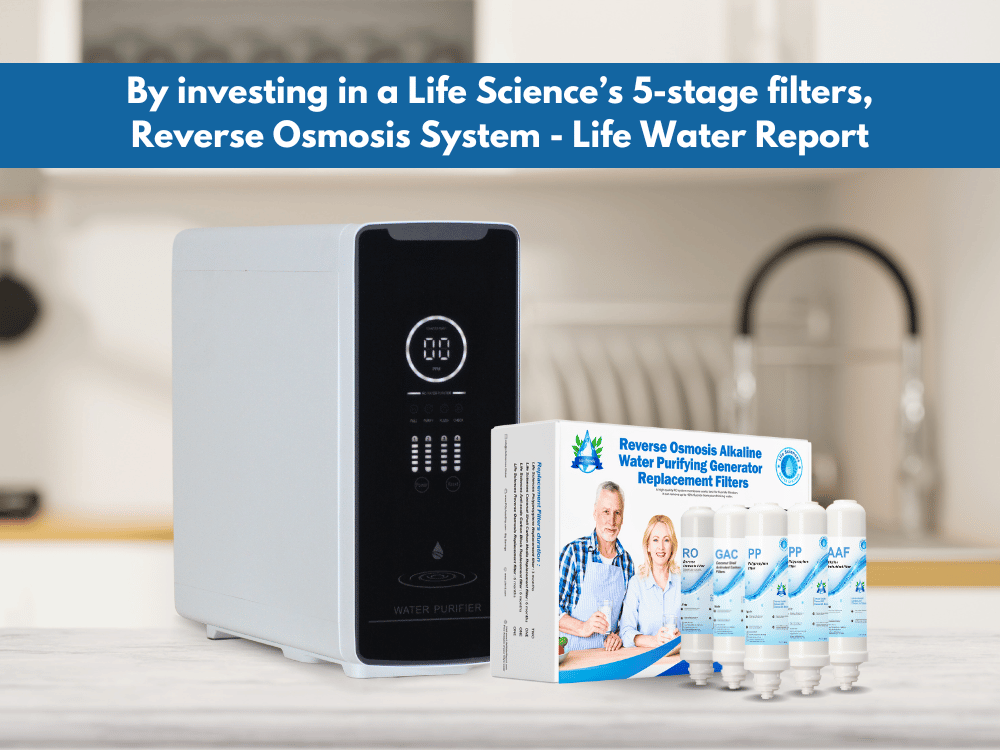At Life Water Report, we believe in providing you with the most accurate and detailed information about various aspects of water quality. Throughout this guide, we will explore the concept of Total Dissolved Solids (TDS) and their impact on water taste and health effects.
You can ensure drinking water quality by understanding TDS and its measurement.
What are Total Dissolved Solids (TDS)?
Total dissolved solids stands for the concentration of combined minerals, salts, metals, and dissolved substances in water.
Some water filtration systems, like those offered by Zero Water, aim to eliminate these dissolved solids entirely, providing what is commonly called “pure” water. Reverse osmosis systems also create “pure” water and this water has serious health implications
as water with no minerals is electron deficient. This causes the water to “steal” electrons, in the form of minerals, from your body’s bones and tissues. This bone loss is highly detrimental to one’s health.
The Impact of TDS on Water Taste and Appearance
Increased TDS levels in water can affect taste and appearance. It is responsible for the characteristic taste often described as “hard” or “mineral-like.”
If you’ve ever noticed that your tap water tastes different when you travel to a different area, it could be due to varying Total Dissolved Solids levels. High levels can also lead to cloudy or discolored water.

Water exposure to Total Dissolved Solids
Natural TDS Sources
All-natural water contains minerals and dissolved substances. TDS minerals include calcium, magnesium, potassium, sodium, carbonates, bicarbonates, chlorides, and sulfates. These minerals generally benefit human health.
It’s imperative to know that they can also contain harmful substances like lead, mercury, arsenic, pharmaceuticals, hormones, nitrates, pesticides, herbicides, and insecticides.
Human Activities and Total Dissolved Solids
Total dissolved solids originate from natural sources and human activities.
- Spring water: Water from springs has elevated levels of dissolved solids due to passing through regions with high salt content in rocks.
Certain areas, like North America’s prairies, may have increased TDS concentrations due to higher amounts of calcium and magnesium in the ground. - Human activities also contribute to Total Dissolved Solids levels. The use of toxic chemicals, pesticides, and fertilizers.
- Agricultural runoff and wastewater discharges can introduce excess contaminants into water sources.
- Road salt used for de-icing roads can impact water quality.
- Improper pharmaceutical disposal down the toilet or drain also affects drinking water quality and levels.
Determine the Ideal TDS Level for Drinking Water
By identifying its level, you can assess the potential impact on taste, appearance, and overall water quality.
The Environmental Protection Agency (EPA) suggests that community water systems should contain 500 mg/L (500 ppm) or less of total dissolved solids.
Ideally, TDS in drinking water should be between 300 and 500 ppm. This is if the TDS consists of naturally occurring minerals like calcium, potassium, and magnesium.

Understanding different Total Dissolved Solids ranges can provide valuable insights:
- Low TDS (<50 – 300 ppm): Water with low TDS may lack essential minerals beneficial to health.
- Excellent TDS (300 – 500 ppm): ideal level in drinking water
- Fair TDS (500 – 1,000 ppm): consider an appropriate filtration system to lower your Total Dissolved Solid.
- Poor TDS (1,000 – 1,999 ppm): Use an appropriate filter system to lower it.
- Unacceptable TDS (> 2,000 ppm): Levels above 2000 ppm are unsafe and household filters cannot handle them.
Water quality report:
If your water comes from a municipal source, you can request a water report from your water provider. The TDS level of your water is included in this report.
If you are concerned about the quality of your water, it’s a wise idea to go to this website, http://www.LifeWaterReport.com
Consider a range of treatment options to ensure your safety and health. Start controlling your Family’s water quality today by scheduling your free water test.
Methods to Reduce or Remove Total Dissolved Solids
Zero tds filters, such as Reverse osmosis systems are designed to eliminate nearly all Total Dissolved Solids or reduce it to a very low level (below 50 ppm). Which is bad for your health.
If your TDS level is above 500 ppm, a reverse osmosis system would be the best water treatment method to reduce or remove TDS.
Water distiller: You can also use a water distiller or a deionization (DI) system to completely remove TDS. Deionization is the only purification process that delivers a true 0 TDS level. Which is not good for your health.
The Role of Life Water STAGE REVERSE OSMOSIS SYSTEM WITH MINERAL CARTRIDGE & HOUSING
To ensure the best-tasting water, it is essential to reduce total dissolved solids in your drinking water. LifeWater® offers innovative 5-stage water filters that remove 99.6% of total dissolved solids.
RO systems can effectively remove a wide range of contaminants, including minerals, salts, metals, and other dissolved substances that contribute to TDS.
Note: some trace minerals and elements present in TDS, like calcium and magnesium, provide health benefits. In such cases, a small amount of TDS is desired in the treated water. Although water can be a source of minerals, relying solely on low TDS water for hydration might lead to mineral depletion in bones.
As for practical filtration and purification, we suggest you install a reverse osmosis (RO) system with a post-alkaline mineral system or install a multi-filter countertop unit that removes the majority of toxic chemicals and then Creates alkalized mineral water with antioxidants. For this post-treatment remineralization techniques can be employed to reintroduce essential minerals into purified water.
By investing in Life Science’s 5-stage filters, Reverse Osmosis System – Life Water Report
You can enjoy enhanced water quality, improved taste, and over 40 scientifically confirmed health benefits.

Call to action:
it’s important to know about high TDS and low TDS levels in water. A high TDS level indicates a significant concentration of dissolved solids in the water, which can affect its taste and appearance. On the other hand, a low TDS level signifies fewer dissolved solids present. This results in water composed of pure water molecules. This distinction is crucial when it comes to water quality and purity.
In conclusion, Total Dissolved Solids (TDS) determine drinking water’s taste and appearance. LifeWater® 5-stage filters with post-mineral cartridges reduce TDS effectively and provide clean, refreshing water, and its mineral cartridge provides water with essential minerals. https://lifewaterreport.com/
When a Life Customer orders any of the top Life Water Ionizers, we analyze their Life Water Report. We supply a FREE multi-stage Pre-Filter System to remove all contaminants.
- Samuel R. (2022). Total Dissolved Solids TDS Less than 1000 ppm in Drinking Water Did Not Impact Nursery Pig Performance. Veterinary sciences, 9(11), 622. https://doi.org/10.3390/
vetsci9110622 - Guidelines for drinking-water quality: Fourth edition incorporating the first and second addenda [Internet]. Geneva: World Health Organization; 2022. [Table, Total dissolved solids]. Available from: https://www.ncbi.nlm.nih.gov/
books/NBK579460/table/ch12. tab134/ - Butler, B. A., & Ford, R. G. (2018). Evaluating relationships between total dissolved solids (TDS) and total suspended solids (TSS) in a mining-influenced watershed. Mine water and the environment, 37(1), 18–30. https://doi.org/10.1007/
s10230-017-0484-y - Colburn, A. S., Meeks, N., Weinman, S. T., & Bhattacharyya, D. (2016). High Total Dissolved Solids Water Treatment by Charged Nanofiltration Membranes Relating to Power Plant Applications. Industrial & engineering chemistry research, 55(14), 4089–4097. https://doi.org/10.1021/acs.
iecr.6b00098
